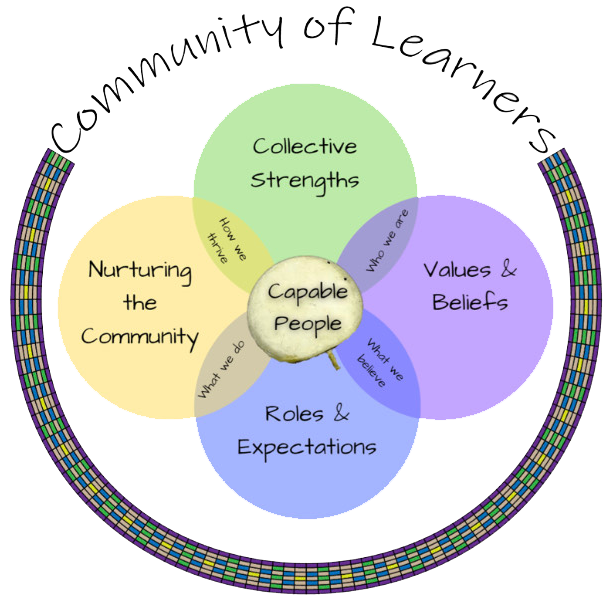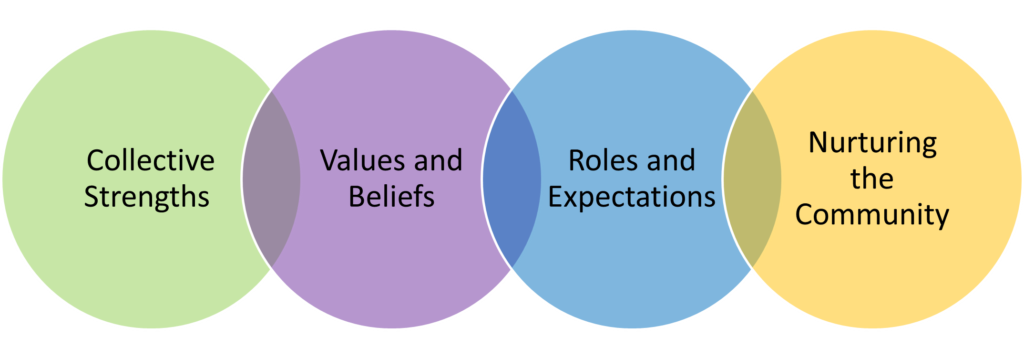What is the Community of Learners?

Definition
The Community of Learners is a framework for creating safe, inclusive spaces, that focus on oracy development and learning from and with students about their strengths, talents, gifts and interests. This is a framework to setting up classrooms that are spaces for Inquiry learning to thrive. This is an approach to learning that is research based and includes elements of restitution and restorative practices, Reconciliation Education, Supporting Individuals through Attachment (SIVA) and Inclusive Education. It respects relationship building that is grounded in the place and context of the Gwich’in and Inuvialuit people and the Dene Kede and Innuuqatigiit.
Goals
- That teachers learn about the students and SAs in their classrooms, so that programming can match their strengths and interests
- To create learning environments that are equitable, inclusive, and promote student voice and agency and prepare students for deep inquiry based learning.
- To help students develop collaboration, communication, and resilience skills that they can employ in all aspects of future learning in and out of the classroom.
- That teachers take learning outside and into the community. They are learning, with the community about where they are, the stories, and histories of the people they are teaching.
NOTE: Teachers are still teaching curriculum during September. We are asking teachers to teach curriculum skills and use the structures and routines in these components to help students learn and engage with content during September. There are many ways to map the curriculum skills that are being learned and demonstrated through the lessons and activities in the Community of Learners. This is not “THIS instead of THAT– it is THIS as a vehicle for THAT.”
Components of a Community of Learners
As teachers, we program to the strengths and talents of students in the ways we both guide and create learning opportunities for them. We can help program for engagement, help identify areas that require spiral reinforcement, build in experiential learning aspects to literacy and numeracy tasks, model collaboration, and relationality to make our work authentic to a values and beliefs driven practice, aligned with the guiding forces in Indigenous communities. If we approach our role as a key member of a community whose gifts and talents can help lift others to nurture theirs– our community will flourish. In our work, the “How” we teach, model, lead and learn is the main focus of our role in Indigenizing Education.
Elements in Each Component:
- Guiding understanding
- Big idea
- Essential question
- Culminating task
- Connections to key
- Competencies
- Connections to a capable person
- Connection to land and place
- Inquiry type
- Oracy strategy
- Possible pathways
- Teacher reflection
- Resource sheet
- Activities
- Check in with yourself

Creating a Community of Learners
Why do we want to focus on creating a community of learners within the classroom?
In classrooms that are set up as communities of learners, students feel engaged to take risks in their learning in an environment where all members feel valued and safe, understand clear expectations of roles and contributions, and are nurtured to grow and glow with their peers.
This approach to relationship building:
- Is inclusive
- Is grounded in Indigenous worldviews of the Gwich’in and Inuvialuit people
- Utilizes principles and strategies of self-regulation
- Fosters psychological safety and trust
- Is connected to principles of restitution
This relationship building time helps teachers:
- Support the development of self regulated learners
- Foster a strengths and gifts based approach to teaching and learning
- Make personal and collective accountability the focus of classroom management
- Build and support oracy and oral communication
- Build teamwork in the classroom through collaboration and communication
- Learn with and from students
- Set up the conditions for Inquiry learning to thrive
BDDEC teachers who walk through the process of creating a community of learners have classrooms that are safe and inclusive and places where success is possible for all. Places where relational and holistic learning drive the work and students are the center. All members of the classroom community are on a journey towards becoming capable and celebrating successes along the way.
Shelley Moore on Places of Belonging
The Learning Bundle
In the Dene perspective, each child enters the world with gifts and talents and a learning bundle that is with them from birth to the end of their life.
This bundle is tied to the spirit and is added to and changed as a child grows in learning. The tools in the learning bundle grow and empower a child to navigate the complexities of walking in two worlds (their cultural community life and the demands and realities of the western world).
Every child is born with intellect. This is unique; no two children think and interact with the world in the same way and there is no hierarchy between the intelligences of children. Each child’s bundle also includes a child’s gifts and talents which grow as they are identified and nurtured by those around them. In the bundle there is wisdom and curiosity as well as passions – these grow as learning and experiences happen. The tools to navigate conflict and consequence are present in the bundle and must be nurtured in positive ways in order to fill the spirit and not destroy it. The bundle provides for self-reflection in order for the child to contemplate what needs to be added or removed as they grow in years and face different challenges in their life and learning.
It is important to help connect children to their Elders and community in as many ways and situations as possible, as it is through these relationships that they learn to grow and use the tools in their bundles. When a child understands they are surrounded by Elders, mentors, and family in their educational journey they will thrive in their learning and their bundles will be full as they face new and difficult challenges in the world.
Teaching with this in mind will help you deepen your connection to the community of learners you will help to form in your classrooms and it will certainly help create conditions for deeply engaging learning to thrive. It has been said many times that it takes a village to raise a child – but it definitely takes a community to educate one!
Reflect: In ALL aspects of your day, how are you attending to the learning bundles of the students you interact with?
Inclusive Education
The Community of Learners framework is inclusive and recognizes that every member of the community has strengths, gifts and talents to share. Students enter into this work with different learning strengths and stretches and should be encouraged to participate in a way that meets their functional ability. To build a community of learners with a strong foundation it is essential that students are met at their current level and provided the tools and strategies to be successful. Equity and equality in a community looks and feels different for each member and relationships are built by respecting these differences.
Throughout the components of the COL it might be necessary for educators to access support, knowledge and resources from PSTs, SA’s, family members, administration and previous teachers on how they can best meet the needs of students. Participation and input in Community of Learners activities should never be expected if it is deteriorating relationships and damaging the community. Some members of the classroom community might need additional individual plans to be a successful member of the community. Collaboration with the school based support team can ensure that all students can be successful members of the community.

